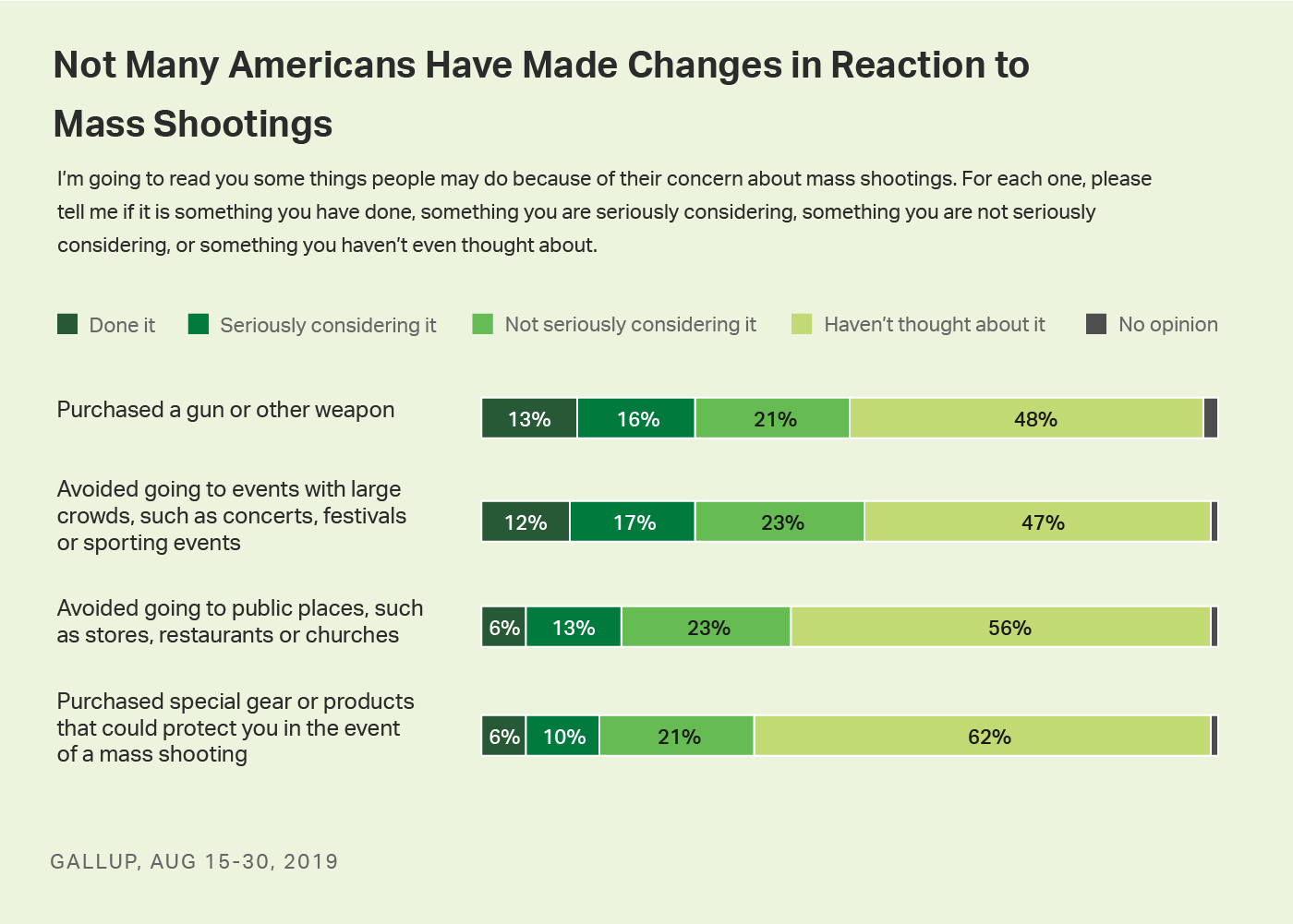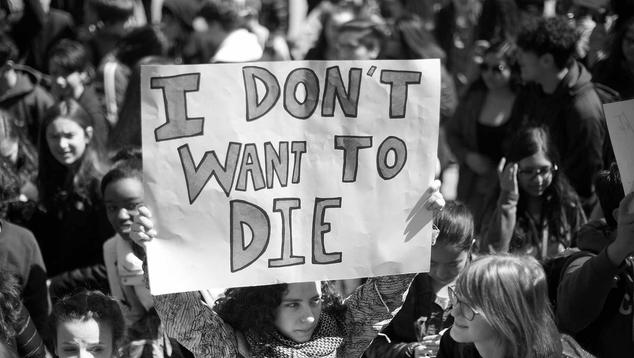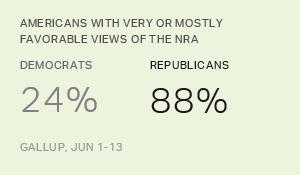Story Highlights
- 48% worried about being victim of mass shooting
- Women, younger adults and Democrats continue to be most worried
- More than 10% have avoided large crowds or bought weapon because of worry
WASHINGTON, D.C. -- In the wake of two August mass shootings that claimed the lives of 31 people in one weekend, Americans are more worried about themselves or a family member being the victim of a mass shooting than they were after two previous massacres. Currently, 48% of U.S. adults are "very" or "somewhat" worried, compared with 39% in 2017 after one gunman killed 58 people in Las Vegas and 38% in 2015 after a San Bernardino shooter left 14 dead.
| Very worried | Somewhat worried | Not too worried | Not worried at all | ||||||||||||||||||||||||||||||||||||||||||||||||||||||||||||||||||||||||||||||||||||||||||||||||
|---|---|---|---|---|---|---|---|---|---|---|---|---|---|---|---|---|---|---|---|---|---|---|---|---|---|---|---|---|---|---|---|---|---|---|---|---|---|---|---|---|---|---|---|---|---|---|---|---|---|---|---|---|---|---|---|---|---|---|---|---|---|---|---|---|---|---|---|---|---|---|---|---|---|---|---|---|---|---|---|---|---|---|---|---|---|---|---|---|---|---|---|---|---|---|---|---|---|---|---|
| % | % | % | % | ||||||||||||||||||||||||||||||||||||||||||||||||||||||||||||||||||||||||||||||||||||||||||||||||
| August 2019 | 19 | 29 | 27 | 25 | |||||||||||||||||||||||||||||||||||||||||||||||||||||||||||||||||||||||||||||||||||||||||||||||
| October 2017 | 10 | 29 | 34 | 26 | |||||||||||||||||||||||||||||||||||||||||||||||||||||||||||||||||||||||||||||||||||||||||||||||
| December 2015 | 11 | 27 | 35 | 27 | |||||||||||||||||||||||||||||||||||||||||||||||||||||||||||||||||||||||||||||||||||||||||||||||
| GALLUP, Aug 15-30, 2019 | |||||||||||||||||||||||||||||||||||||||||||||||||||||||||||||||||||||||||||||||||||||||||||||||||||
The most recent poll was conducted August 15-30, less than two weeks after back-to-back shootings in a 13-hour period -- 9 people were killed in Dayton, Ohio and 22 were killed in a Walmart store in El Paso, Texas. The 2015 and 2017 polls were conducted in the immediate aftermath of the shootings; the latest readings may have been even higher had the poll happened closer to the shootings.
In all, 19% of U.S. adults are very worried, 29% are somewhat worried, 27% are not too worried and 25% are not worried at all about becoming the victim of a mass shooting. There are stark differences in the levels of worry between some demographic subgroups. Most notably, Democrats and Democratic-leaning independents, those who do not personally own a gun, women and younger adults are all significantly more worried than their counterparts.
| October 2017 | August 2019 | Change | ||||||||||||||||||||||||||||||||||||||||||||||||||||||||||||||||||||||||||||||||||||||||||||||||||
|---|---|---|---|---|---|---|---|---|---|---|---|---|---|---|---|---|---|---|---|---|---|---|---|---|---|---|---|---|---|---|---|---|---|---|---|---|---|---|---|---|---|---|---|---|---|---|---|---|---|---|---|---|---|---|---|---|---|---|---|---|---|---|---|---|---|---|---|---|---|---|---|---|---|---|---|---|---|---|---|---|---|---|---|---|---|---|---|---|---|---|---|---|---|---|---|---|---|---|---|---|
| % | % | pct. pts. | ||||||||||||||||||||||||||||||||||||||||||||||||||||||||||||||||||||||||||||||||||||||||||||||||||
| All U.S. adults | 39 | 48 | +9 | |||||||||||||||||||||||||||||||||||||||||||||||||||||||||||||||||||||||||||||||||||||||||||||||||
| Gender | ||||||||||||||||||||||||||||||||||||||||||||||||||||||||||||||||||||||||||||||||||||||||||||||||||||
| Women | 53 | 58 | +5 | |||||||||||||||||||||||||||||||||||||||||||||||||||||||||||||||||||||||||||||||||||||||||||||||||
| Men | 26 | 38 | +12 | |||||||||||||||||||||||||||||||||||||||||||||||||||||||||||||||||||||||||||||||||||||||||||||||||
| Age group | ||||||||||||||||||||||||||||||||||||||||||||||||||||||||||||||||||||||||||||||||||||||||||||||||||||
| 18-34 | 47 | 54 | +7 | |||||||||||||||||||||||||||||||||||||||||||||||||||||||||||||||||||||||||||||||||||||||||||||||||
| 35-54 | 41 | 46 | +5 | |||||||||||||||||||||||||||||||||||||||||||||||||||||||||||||||||||||||||||||||||||||||||||||||||
| 55+ | 33 | 44 | +11 | |||||||||||||||||||||||||||||||||||||||||||||||||||||||||||||||||||||||||||||||||||||||||||||||||
| Party ID | ||||||||||||||||||||||||||||||||||||||||||||||||||||||||||||||||||||||||||||||||||||||||||||||||||||
| Democrats/Democratic-leaning independents | 49 | 64 | +15 | |||||||||||||||||||||||||||||||||||||||||||||||||||||||||||||||||||||||||||||||||||||||||||||||||
| Republicans/Republican-leaning independents | 27 | 27 | 0 | |||||||||||||||||||||||||||||||||||||||||||||||||||||||||||||||||||||||||||||||||||||||||||||||||
| Gun or non-gun owner | ||||||||||||||||||||||||||||||||||||||||||||||||||||||||||||||||||||||||||||||||||||||||||||||||||||
| Personally do not own a gun | 47 | 58 | +11 | |||||||||||||||||||||||||||||||||||||||||||||||||||||||||||||||||||||||||||||||||||||||||||||||||
| Personally own a gun | 23 | 30 | +7 | |||||||||||||||||||||||||||||||||||||||||||||||||||||||||||||||||||||||||||||||||||||||||||||||||
| GALLUP | ||||||||||||||||||||||||||||||||||||||||||||||||||||||||||||||||||||||||||||||||||||||||||||||||||||
Except for partisanship, worry among each of these groups has remained the same or increased since 2015. In 2015 when Barack Obama was president, Democrats were less worried than Republicans about being a victim of a mass shooting and Republicans were more worried. With President Donald Trump in the White House, those levels of worry have flipped. Currently, 64% of Democrats and 27% of Republicans are very or somewhat worried. In 2015, 46% of Republicans and 32% of Democrats registered the same degree of worry.
While women have consistently expressed greater worry than men about being the victim of a mass shooting in all three polls, men have also become more worried in the past two years. The 20-point gender gap on the issue is smaller than it was in 2017, but the same as in 2015. In 2015, 48% of women and 28% of men were at least somewhat worried.
Few Measures Being Taken to Avoid Mass Shooting
Despite Americans' heightened concern, few are taking any of four measures tested by Gallup to avoid being the victim of a mass shooting. These questions, asked for the first time in August, assessed whether Americans' concern about mass shootings has caused them to avoid public places like stores, restaurants or churches, avoided events with large crowds such as concerts, festivals or sporting events, purchased a gun or other weapon, or purchased special products to protect them in the event of a mass shooting.
The largest percentages doing any of these is 13% for purchasing a gun and 12% for avoiding events with large crowds. About half as many say they have avoided stores or other public places (6%) or purchased protective products (6%). For the most part, these four precautions haven't even entered Americans' minds. Majorities say they have not thought about purchasing protective equipment (62%) or avoiding public places (56%).

Women are more likely than men to say they have avoided going to events where large crowds are present, 17% vs. 7%, but men are more likely to have purchased a gun or other weapon (16%) than women (10%).
Those who say they are very worried about being the victim of a mass shooting are much more likely than those who are less worried to say they avoid going to events with large crowds (30%) and they avoid going to public places (20%).
Bottom Line
Americans' level of worry that they or a family member will be the victim of a mass shooting is higher than it was after two previous mass shootings. Previous Gallup research has shown that Americans are more likely to mention guns or gun control as the most important problem facing the country in the immediate aftermath of prior mass shootings, and over time, that concern wanes. In Gallup's August update of the most important problem question, there was a similar spike in mentions of guns or gun control. The September update, out later this month, will tell if the issue remains a high priority for Americans or as usual, has dissipated over time.
Likewise, as further mass shootings continue to occur in the U.S., more Americans may begin to change their lifestyles to avoid becoming a victim. For now, though, most in the U.S. are not taking drastic measures.




